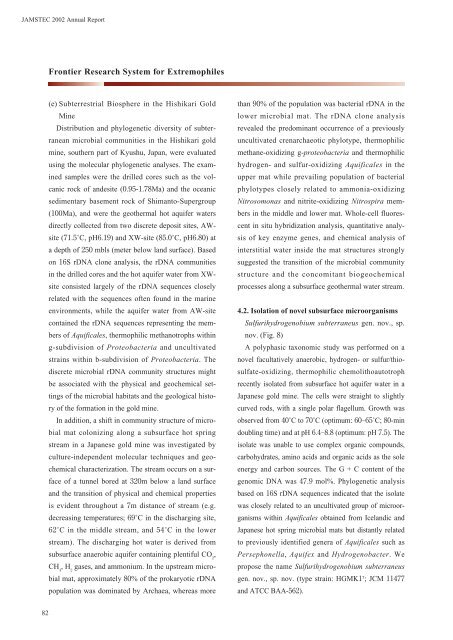Marine Ecosystems Research Department - jamstec japan agency ...
Marine Ecosystems Research Department - jamstec japan agency ...
Marine Ecosystems Research Department - jamstec japan agency ...
Create successful ePaper yourself
Turn your PDF publications into a flip-book with our unique Google optimized e-Paper software.
JAMSTEC 2002 Annual Report<br />
Frontier <strong>Research</strong> System for Extremophiles<br />
(e) Subterrestrial Biosphere in the Hishikari Gold<br />
Mine<br />
Distribution and phylogenetic diversity of subterranean<br />
microbial communities in the Hishikari gold<br />
mine, southern part of Kyushu, Japan, were evaluated<br />
using the molecular phylogenetic analyses. The examined<br />
samples were the drilled cores such as the volcanic<br />
rock of andesite (.-.Ma) and the oceanic<br />
sedimentary basement rock of Shimanto-Supergroup<br />
(Ma), and were the geothermal hot aquifer waters<br />
directly collected from two discrete deposit sites, AWsite<br />
(.˚C, pH.) and XW-site (.˚C, pH.) at<br />
a depth of mbls (meter below land surface). Based<br />
on S rDNA clone analysis, the rDNA communities<br />
in the drilled cores and the hot aquifer water from XWsite<br />
consisted largely of the rDNA sequences closely<br />
related with the sequences often found in the marine<br />
environments, while the aquifer water from AW-site<br />
contained the rDNA sequences representing the members<br />
of Aquificales, thermophilic methanotrophs within<br />
g-subdivision of Proteobacteria and uncultivated<br />
strains within b-subdivision of Proteobacteria. The<br />
discrete microbial rDNA community structures might<br />
be associated with the physical and geochemical settings<br />
of the microbial habitats and the geological history<br />
of the formation in the gold mine.<br />
In addition, a shift in community structure of microbial<br />
mat colonizing along a subsurface hot spring<br />
stream in a Japanese gold mine was investigated by<br />
culture-independent molecular techniques and geochemical<br />
characterization. The stream occurs on a surface<br />
of a tunnel bored at m below a land surface<br />
and the transition of physical and chemical properties<br />
is evident throughout a m distance of stream (e.g.<br />
decreasing temperatures; ˚C in the discharging site,<br />
˚C in the middle stream, and ˚C in the lower<br />
stream). The discharging hot water is derived from<br />
subsurface anaerobic aquifer containing plentiful CO <br />
,<br />
CH <br />
, H <br />
gases, and ammonium. In the upstream microbial<br />
mat, approximately % of the prokaryotic rDNA<br />
population was dominated by Archaea, whereas more<br />
than % of the population was bacterial rDNA in the<br />
lower microbial mat. The rDNA clone analysis<br />
revealed the predominant occurrence of a previously<br />
uncultivated crenarchaeotic phylotype, thermophilic<br />
methane-oxidizing g-proteobacteria and thermophilic<br />
hydrogen- and sulfur-oxidizing Aquificales in the<br />
upper mat while prevailing population of bacterial<br />
phylotypes closely related to ammonia-oxidizing<br />
Nitrosomonas and nitrite-oxidizing Nitrospira members<br />
in the middle and lower mat. Whole-cell fluorescent<br />
in situ hybridization analysis, quantitative analysis<br />
of key enzyme genes, and chemical analysis of<br />
interstitial water inside the mat structures strongly<br />
suggested the transition of the microbial community<br />
structure and the concomitant biogeochemical<br />
processes along a subsurface geothermal water stream.<br />
4.2. Isolation of novel subsurface microorganisms<br />
Sulfurihydrogenobium subterraneus gen. nov., sp.<br />
nov. (Fig. )<br />
A polyphasic taxonomic study was performed on a<br />
novel facultatively anaerobic, hydrogen- or sulfur/thiosulfate-oxidizing,<br />
thermophilic chemolithoautotroph<br />
recently isolated from subsurface hot aquifer water in a<br />
Japanese gold mine. The cells were straight to slightly<br />
curved rods, with a single polar flagellum. Growth was<br />
observed from ˚C to ˚C (optimum: –˚C; -min<br />
doubling time) and at pH .–. (optimum: pH .). The<br />
isolate was unable to use complex organic compounds,<br />
carbohydrates, amino acids and organic acids as the sole<br />
energy and carbon sources. The G + C content of the<br />
genomic DNA was . mol%. Phylogenetic analysis<br />
based on S rDNA sequences indicated that the isolate<br />
was closely related to an uncultivated group of microorganisms<br />
within Aquificales obtained from Icelandic and<br />
Japanese hot spring microbial mats but distantly related<br />
to previously identified genera of Aquificales such as<br />
Persephonella, Aquifex and Hydrogenobacter. We<br />
propose the name Sulfurihydrogenobium subterraneus<br />
gen. nov., sp. nov. (type strain: HGMK T ; JCM <br />
and ATCC BAA-).<br />
82
















